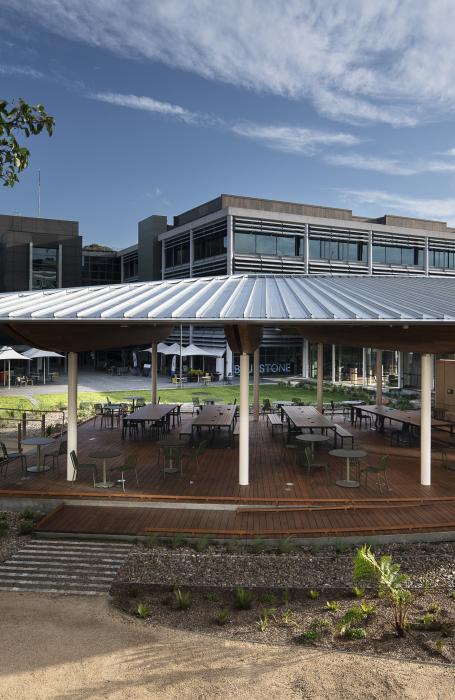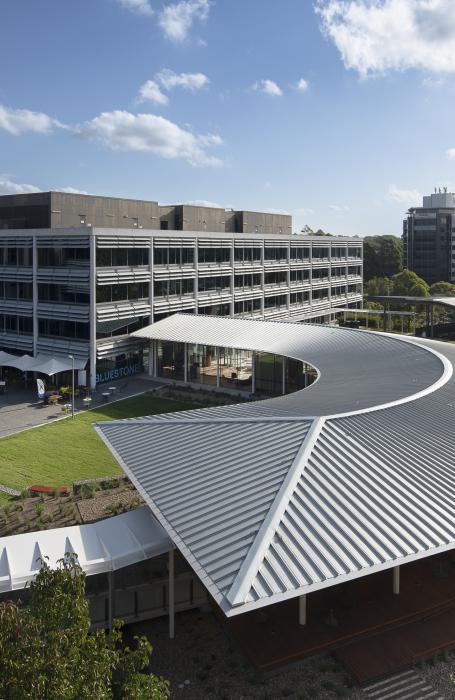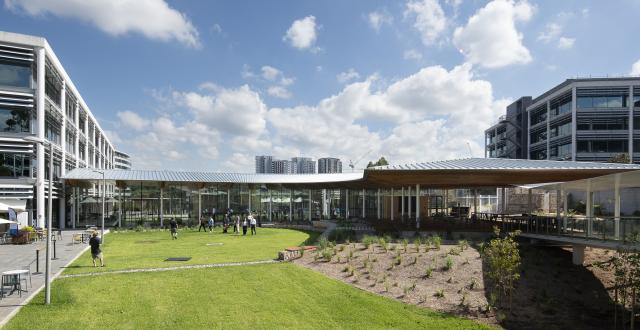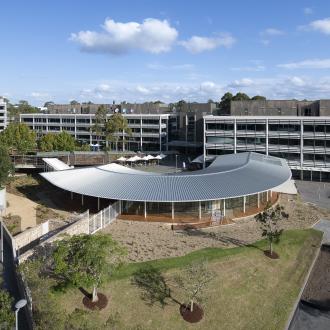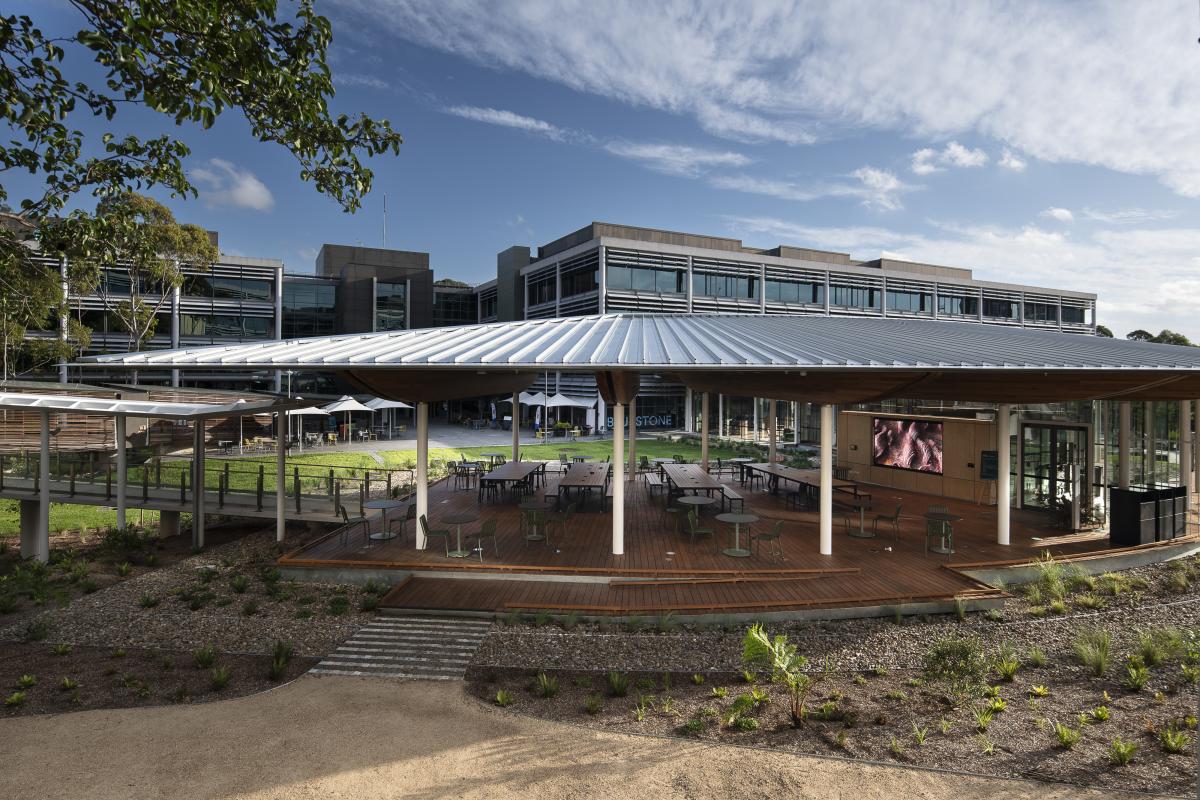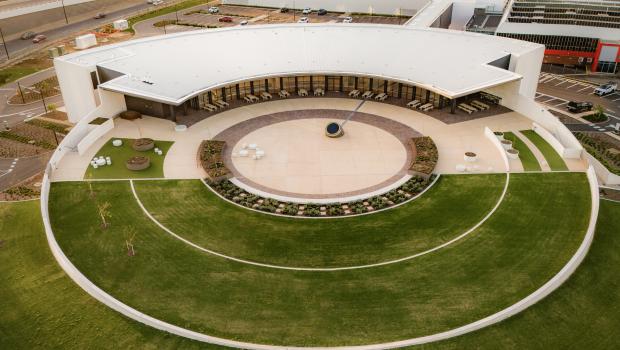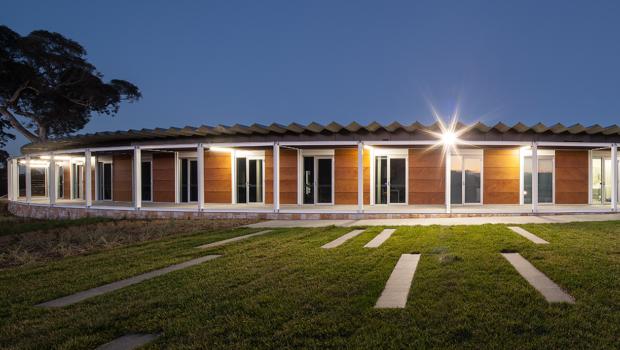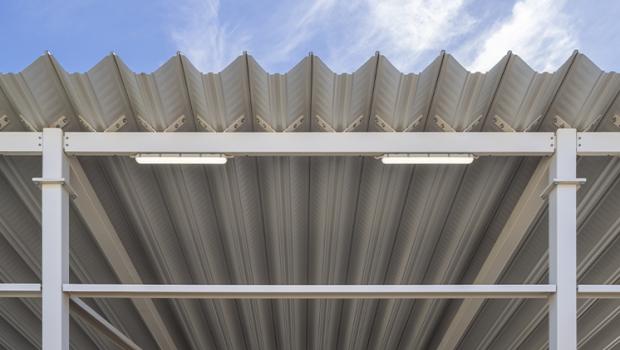Project background
The O Pavilion is the new front door to the Optus Campus at Macquarie Park. Designed as a central meeting point for staff, visitors and collaborators, the Pavilion is part of a wider strategy to create flexible, people-focused spaces within the campus.
With five surrounding office buildings looking down onto it, the Pavilion’s roof became a major visual feature of the design. The finish needed to be flawless from every angle, with no room for error or visual compromise.
“Roofing often doesn’t get this much visual attention, but in this case, it had to be flawless. The finished roof had to look as good from above as it did underneath,” said Jess Lindsay, BDM of Fielders’ Architectural Design Solutions, NSW.
It also needed to accommodate a tight tapering radius, meet high acoustic performance requirements, and align exactly with the structural steelwork beneath it.
“When we looked at the roof plan, it was right on our minimum and maximum limits,” explained Thane Burdon, National Engineering and Mobile Mill Manager at Bluescope. “That makes it tricky. There’s no room for error or adjustment if the steelwork doesn’t match the plans perfectly.”
Fielders solution
The Pavilion roof design demanded a flexible solution that could adapt to the structure as built.
“Although complex, the roof installation is the easy part. The hard work is early coordination with the builder and fellow subcontractors to ensure the steel work that is provided to us suits the roof profile capabilities and required roof installation methods,” explained David Hanson, Director of Axis Metal Roofing.
During the design resolution phase, concerns were raised about the suitability of the originally specified profile for the tight radius and performance requirements. Axis recommended bringing Fielders into the conversation to help deliver a solution that would maintain the architectural intent.
“We believed their FreeForm® roofing profile would achieve the project requirements. Fielders were very helpful with their early involvement, which included site visits with their on-site roll forming team and many discussions with their technical department. This contributed to the success of the project.”
FreeForm®’s tapered capability, combined with on-site rolling, allowed the team to work with the structure as built, while still delivering the precise geometry required.
“Once a building shape is approved, there’s not much flexibility to change form,” said Jess. “What FreeForm® allowed us to do was work within that approved shape and still achieve the design intent, because we could adjust and control the taper during installation.”
For Bluescope’s Mobile Mill team, working to tight tolerances is nothing new, but this project raised the bar. “This project didn’t allow for even a few millimetres of error. The tolerance was so tight that we had to be spot on at every stage,” said Thane.
Project execution
The Pavilion roof installation was a process of constant coordination and precision adjustments. On-site roll forming managed the complexity of the curved geometry while keeping the project on track.
“Roll forming on site is helpful, especially with the curved roof. Site roll forming allows us to alter lengths as needed due to the curve of the roof. It limits waste (off-cuts) and enables changes when required,” commented David.
Fielders’ FreeForm®, combined with the Mobile Mill’s on-site rolling capability, gave the team the flexibility to respond in real time. Sheets were rolled in controlled batches, checked against the radius, and fine-tuned on the spot to keep the installation aligned and flowing smoothly.
At times, sheet taper was being adjusted by as little as 2 to 5 millimetres per batch to stay on the radial line. The roofing team worked closely with the Mobile Mill, placing sheets and feeding back measurements in real time to ensure every curve landed exactly where it needed to.
“Every measurement had to be accurate,” said Thane. “The coordination between us and Axis Metal Roofing was critical. They were fantastic to work with.”
Outcomes
The Pavilion roof was a project that pushed design, coordination, and installation to their limits. With every detail exposed to view, the team had to create a solution that was as precise as it was visually striking.
“FreeForm® contributed to the geometry, the performance, and the visual outcome,” said Jess. “The ribs created a continuous, graduated band look that was critical for a roof viewed from above by surrounding buildings.”
For Axis Metal Roofing, the success of the project came down to execution. “We are proud of the result,” said David. “The workmanship is second to none and we completed the work in the programmed time.”
Thane credited the result to the team’s shared commitment. “Everyone’s attention to detail made the difference. The collaboration between the Fielders team, Axis Roofing, and the builder was excellent.”
Learnings
The success of the project came down to a combination of technical expertise, proactive collaboration, and the flexibility to adapt in real time. Key learnings from the project include:
- Involve technical partners early - Bringing Fielders into the design resolution phase ensured the roofing solution matched the architectural vision and avoided costly rework later.
- On-site rolling is essential for tight tolerances - With no margin for error, the ability to adjust sheet lengths and tapers on site was critical to achieving the required geometry and finish.
- Coordination drives precision - Constant communication between Fielders, Axis Metal Roofing and the Mobile Mill team kept every part of the process aligned, from planning to final install.
Conclusion
When there’s no room for error, you need the right partners. Fielders and on-site roll forming provided the precision this project demanded, while close coordination across teams ensured the Pavilion roof was delivered on time, on spec, and with no compromise.
“These are the projects that look deceptively simple but require an incredible amount of technical skill to pull off,” said Jess. “The easiest-looking designs are often the hardest to execute.”
